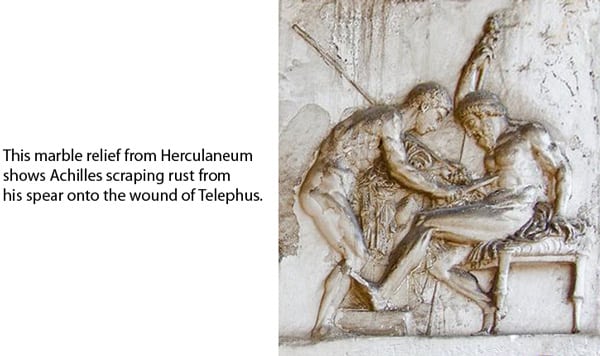Greek mythology tells us that filings from the rusty spear of Achilles were used successfully on a non-healing wound. To this legacy of using metal derivatives to heal wounds, a newer, more modern mythology has been added. This is the use of silver in wound-care dressings.
Telephus was a hero of Ancient Greece who fought in the Trojan War. When fleeing a battle his leg was pierced by Achilles’ spear and he developed a wound which remained unhealed for eight years.

In search of a cure, Telephus visited the Oracle at Delphi who told him that only the warrior who inflicted the wound could cure him. He approached Achilles, who successfully treated him with rust scraped from his spear. Thus we learn that the Ancients utilized metallic salts to heal wounds – a practice that continues today.
A recent Cochrane review examined the effectiveness of silver containing dressings in randomized controlled trials throughout the medical literature. This is what they found:
“Only three trials with a short follow-up duration were found. There is insufficient evidence to recommend the use of silver-containing dressings or topical agents for treatment of infected or contaminated chronic wounds.”
So where does that leave us when picking the best product? I agree with a review article on wound care products published in the Journal of the American Medical Association which wrote about the lack of clinical trials supporting one wound-care modality over another. Treatment choices should be guided by fundamental wound-care principles as well as cost, ease of use, patient comfort and preference. Mythology, though fun to read, should not guide wound care choices, particularly in today’s costly healthcare environment.
Related post: Wound Odor: The View from Ancient Greece.

Dr Levine,
Bronze age weapons could contain copper, zinc, silver, tin,arsenic, or? It would be great to have that spear here to run some composite tests on it. Perhaps corrosion would be more related than rust to what was taking place…
An admirer of your work,
Robert